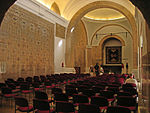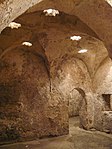Alcázar de los Reyes Cristianos
| Alcázar of the Christian Monarchs | |
|---|---|
| Native name Cordoba, Spain | |
| Coordinates | 37°52′38″N 4°46′55″W / 37.87722°N 4.78194°W |
| Built | 1328 AD (on the site of earlier structures) |
| Architectural style(s) | Spanish, Spanish Gothic |
Europe | |
The Alcázar de los Reyes Cristianos (Spanish for "Castle of the Christian Monarchs"), also known as the Alcázar of Córdoba, is a medieval
It is a building of military character whose construction was ordered by the King Alfonso XI of Castile in the year 1328, on previous constructions (the Islamic-era Umayyad Alcázar, also the previous residence of the Roman Governor and the Customs). The architectural ensemble has a sober character in its exterior and splendid in its interior, with the magnificent gardens and courtyards that maintain a Mudéjar inspiration.
The Alcázar has been declared a
History

In early medieval times, the site was occupied by a
In 1236, Christian forces took Córdoba during the Reconquista. In 1328, Alfonso XI of Castile began building the present day structure on part of the site for the old fortress.[9] Other parts of the Moorish Alcázar had been given as spoils to the bishop, nobles, and the Order of Calatrava.[5] Alfonso's structure retained only part of the Moorish ruins but the structure appears Islamic due to Alfonso's use of the Mudéjar style.
The Alcázar was involved in the civil war where
Henry's successor, Isabella and her husband, Ferdinand, used the Alcázar for one of the first permanent tribunals of the
The Alcázar served as a garrison for
Exterior
-
Tower of Homage
-
Tower of the Lions
-
Tower of the Inquisition
-
Tower of the Dove (left)
Towers
The outdoor area of the Alcázar is situated within the walls of the four towers (Paloma, Leones, Homenaje and Inquisición), this creating an almost square shape to the building.[16]
- Tower of Homage (La torre del Homenaje), of octagonal shape, is situated in the Northeast corner. The tower was previously known as ‘The Clock Tower’ (Torre del Reloj), owing its name to the clock that was previously housed within.[17] The interior has Gothic features including an ogival ceiling.[9]
- Tower of the Lions (La torre de los Leones), of square shape, is situated in the Northwest corner. The door to the base of this tower is currently used as the visitor entrance to the Alcázar.[17] It is the longest standing tower, dating back to the 13th Century, and is named after gargoyles in the shape of lions which are found on the uppermost section of the tower. Within the tower there are two floors; the ground floor, where the reception can be found, and the upper level which accommodates the Chapel of San Eustaquio (La capilla de San Eustaquio), which served as the chapel to the Catholic Monarchs.[18][19]
- Tower of the inquisition (La torre de la Inquisición), of circular shape, is situated in the Southwest corner. It receives its name from the fact that, for centuries, it housed the archives of the Tribunal of the Holy Inquisition (Tribunal de la Santa Inquisition).[20] It was also known as the ‘Tower of the Gardens’ (Torre de los Jardines’).[20]
- Tower of the Dove (La torre de la Paloma), of square shape, is situated in the Southeast corner. The original tower was demolished in the mid-19th century, the current tower being a reconstruction which dates back to the second half of the 20th century. It was also known as ‘The Watch Tower’ (Torre de la Vela).[21]
Interior
-
Hall of Mosaics
-
Courtyard of the Moriscos
-
Courtyard of the Women
-
Reception Hall
-
Royal Baths of Doña Leonor
Hall of Mosaics (Salón de los Mosaicos)
The main hall of the building, constructed in the 18th century, is referred to as the “Hall of Mosaics”, given the impressive Mosaics that can be found within the hall. The mosaics on show were discovered at the Corredera Square (Plaza de la Corredera) towards the end of the 1950s and formed part of the Roman Circus, as well as a sarcophagus from the 3rd Century. The hall is currently a highly sought after civil marriage location by many Cordoban citizens.[16][22]
Beneath the current floor of the hall, it is still possible to discover the remains of which are believed to be from the Royal Baths which were used by high dignitaries during the Muslim era.[citation needed]
Courtyard of the Moriscos (Patio Morisco)
The courtyard of the Moriscos, also known as the Mudejar Courtyard, is situated to the western side of the Alcázar. Taking on a square floor plan, it is surrounded by arched verandas with the exception of its western face. The western face of the patio is where the wall that connects the Tower of the Lions and the Tower of the Inquisition is found, and also through which the Gardens of the Alcázar (Jardines del Alcázar) can be accessed. The patio is centred by a water fountain which sits in-between two ponds.
Courtyard of the Women (Patio de las mujeres)
The courtyard of the Women, also known as the eastern courtyard, is situated to the eastern side of the Alcázar. It owes its name to the era during which the Alcázar was used as a prison, with this courtyard being the location where the feminine section of the prison was located. Many archaeological remains from the different constructive phases of the Alcázar are found in this courtyard, as well as remains of former buildings, the Roman castellum and the Andalusian Alcázar.[23]
Reception Hall (Sala de recepciones)
The reception hall, also known as the Ocean Hall, is a room of square plan which is situated beside the Hall of Mosaics.[24] Incrusted in one of the walls is a Roman mosaic, dedicated to the God Oceanus.[24] Also within the hall are found some seats of honor of the ancient chapter choir which date back to the 17th Century.[24]
Royal Baths of Doña Leonor (Baños reales de Doña Leonor)
The Royal Baths were constructed in 1328 by King Alfonso the 11th.[25] They were structured into four rooms: the changing room, the cold room, the temperate room and the hot room.[25] They owe their name to Leonor de Guzmán, the King's mistress, in whose honour the Royal Baths were constructed.[25]
Gardens of the Alcázar (Jardines del Alcázar)
A set of gardens and orchards have existed in this area since at least the 10th century when Abd ar-Rahman III constructed an aqueduct to bring water from the nearby Albolafia waterwheel (or noria). The gardens have been neglected or renewed at various times since then. In the late 15th century or at the beginning of the 16th century Queen Isabella I ordered the waterwheel's operation to be halted, and they went into a general decline. The current gardens date from a major remodeling around the mid-20th century, while at the same time the area of gardens was reduced in size due to the construction of the Avenue del Alcázar road on its southeast side.[26][15]
Today the gardens consist of an impressive area of approximately 55,000 m2 of magnificent gardens with forest species including
-
General view of the gardens from the Tower of the Lions
-
The Higher Garden
-
The pools of the Middle Garden
-
The pools of the Lower Garden, looking back towards the castle
-
Other manicured gardens in the Lower Garden
-
The Promenade of Kings
-
Statues of the Catholic Monarchs and Christopher Columbus at the Promenade of Kings
Notes
- ^ There is some disagreement among historians as to whether the meeting took place in 1486 or 1487, based on different readings of historical sources. As the Spanish royal court travelled regularly between the cities, the location of the meeting may have been different depending on the exact date, but Cordoba is most likely location according to the sources cited here.
References
- Ministry of Culture of Spain. 2013-06-12.
- ^ "Historic Center of Córdoba". UNESCO Culture Sector.
- ^ "CVC. El jardín andalusí. Jardines de la Córdoba califal. Alcázar". cvc.cervantes.es. Retrieved 2020-10-06.
- ^ Marçais, Georges (1954). L'architecture musulmane d'Occident. Paris: Arts et métiers graphiques. p. 154.
- ^ a b c d Reed, Tony (2005). "Alcázar de los Reyes Cristianos – Córdoba". Infocordoba.com. Archived from the original on 11 May 2006. Retrieved April 4, 2006.
- ^ "Arab Baths of the Caliphal Alcázar of Córdoba - "Caliphal Baths"". Arte en Córdoba. 10 July 2020. Retrieved 2020-10-04.
- ISBN 3822896322.
- ISBN 9781317870418.
- ^ a b "Alcázar de los Reyes Cristianos". Frommer's. Retrieved April 4, 2006.
- ^ "Alcázar de los Reyes Cristianos". Fodor's. Archived from the original on October 11, 2007. Retrieved April 4, 2006.
- ^ ISBN 978-1-4391-0237-4.
- ISBN 978-0-8061-2934-1.
- ISBN 978-0-8283-1993-5.
- ISBN 978-0-670-83725-0.
- ^ a b c "Jardines del Alcázar - Alcázar de los Reyes Cristianos | Visita Virtual". alcazardelosreyescristianos.cordoba.es. Retrieved 2020-10-08.
- ^ a b "Alcázar de los Reyes Cristianos – cordobaturismo.es". cordobaturismo.es (in Spanish). Archived from the original on 2014-04-28. Retrieved 2018-03-07.
- ^ a b "Descripción del Alcázar de los Reyes Cristianos, Córdoba". ArtenCórdoba Visitas Guiadas (in Spanish). Retrieved 2018-03-07.
- ^ Farfán, Lourdes María Morales. "Córdoba: El Alcázar de los Reyes Cristianos". unaventanadesdemadrid.com. Retrieved 2018-03-07.
- ^ "Torre de la Inquisición".
- ^ a b "El Salón de los Mosaicos".
- ^ "Patio de las mujeres".
- ^ "Salón de los Mosaicos – Alcázar de los Reyes Cristianos, Córdoba". ArtenCórdoba Visitas Guiadas (in Spanish). Retrieved 2018-03-07.
- ^ "Audiodescripción de los Baños Reales de Doña Leonor".
- ^ a b c "Paseo de los Reyes".
- ^ a b c "Los Baños reales de Doña Leonor - Alcázar de los Reyes Cristianos | Visita Virtual".
- ^ a b Farfán, Lourdes María Morales. "Córdoba: El Alcázar de los Reyes Cristianos". www.unaventanadesdemadrid.com. Retrieved 2020-10-08.
- ^ "Paseo de los Reyes (1 de 2) - Alcázar de los Reyes Cristianos | Visita Virtual".


















